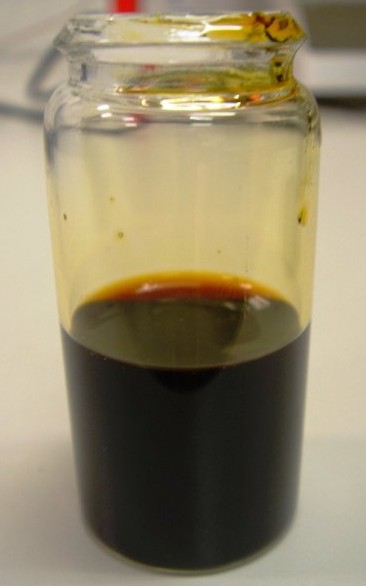Jul
22
Upgrading Bio Oil With a Catalyst
July 22, 2014 | Leave a Comment
Researchers at the University of Twente have developed a simple new catalyst that improves the quality of bio oil. The bio oil they have in mind comes from wood chips or plant residues, which seldom has the same quality and energy content as fossil sourced crude oil. The new catalyst upgrades the bio oil closer to the crude oil standards for refineries.
The idea in Europe is to source fuel destined bio oil not from fruits or seeds, such as palm or rape seed oil, but from plant residues, pruning waste and wood chips, resulting in no competition with the food supply.
Converting plant residues, which take up a lot of space, into oil simplifies transport considerably and the product can go directly to an oil refinery. Blending with crude oil is already possible. However, the quality of this oil does not yet equal that of crude oil. Residue bio oil has a lower energy content per liter, is acid and still contains too much water.
The catalyst developed by Prof. Leon Lefferts and Prof. Kulathuiyer Seshan’s group Catalytic Processes and Materials (MESA+ Institute for Nanotechnology/Green Energy Initiative) significantly improves the quality and energy content of the oil.
The researchers believe the new bio oil product can be better than crude oil.
The new product is made by heating the oil in nitrogen to 500 degrees Celsius and by applying a simple catalyst: sodium carbonate on a layer of alumina. When using this method, the energy content of the bio oil can be boosted from 20 to 33-37 megajoule per kilogram, which is better than crude oil and approximates the quality of diesel.
The technology, recently defended by PhD candidate Masoud Zabeti, is already being tested by KIOR in Texas, USA, on a small industrial scale, with a production of 4,500 barrels of oil per day. The quality of the oil can be improved even more by adding the material caesium, as well as sodium carbonate. “By doing so, we can, for instance, also reduce the aromatics, which are harmful when inhaled,” says Prof. Seshan.
The technology is currently being further studied, in cooperation with the University of Groningen, the Energy research Centre of the Netherlands (ECN) and Utrecht University, in a new CATCHBIO program of the Netherlands Organization for Scientific Research (NWO). The Netherlands is committed to leading the way in research on technology that will help realize the European 2020 fuel objective.
This is a technology much further along than the press release notes. A pilot demonstration at small commercial scale running 4,500 barrels per day is no small feat in today’s circumstances.
What we don’t know are the costs and processes involved to get the raw materials to an oil product and the kind and condition of the waste materials the process chain produces. But, the dream of oil sourced from current plant growth is alive and the new catalyst looks like a major improvement.



